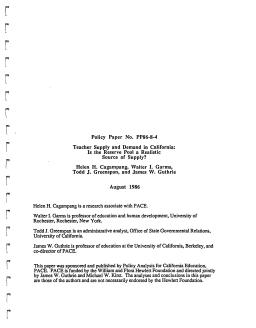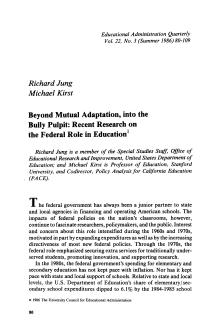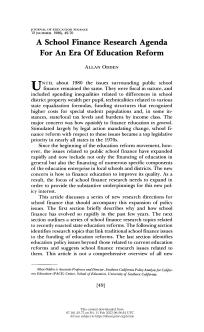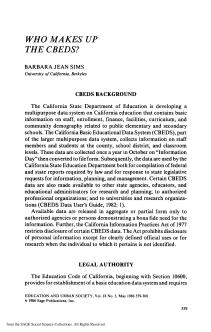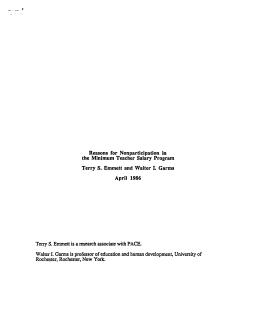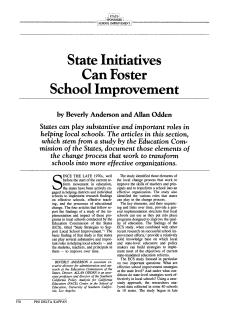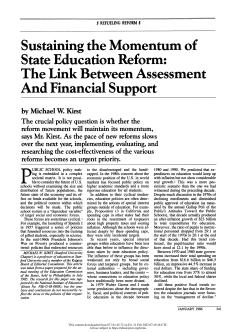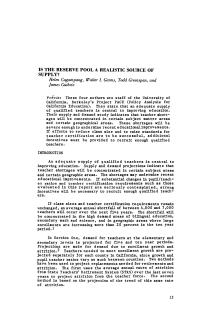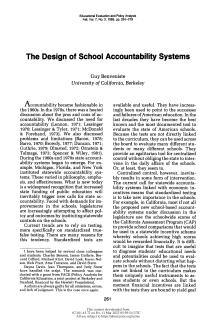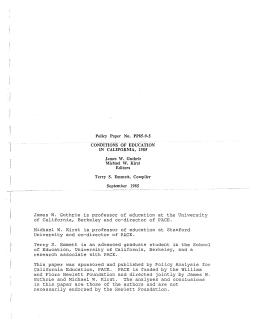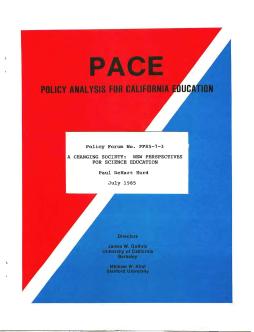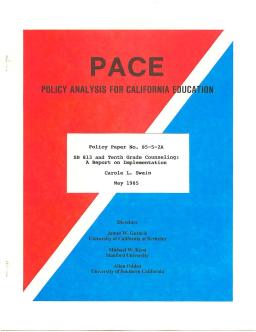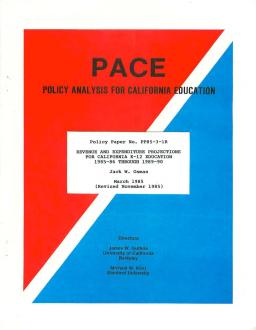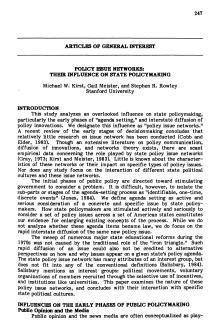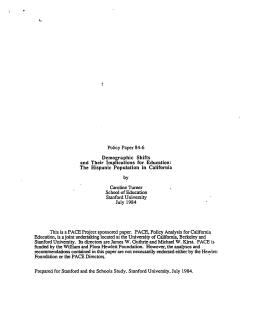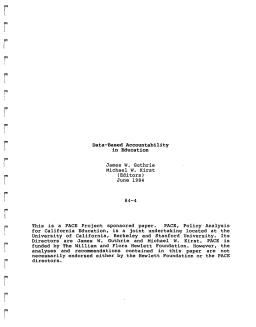Is the Reserve Pool a Realistic Source of Supply?
Published
Summary
Teacher shortages in specific subjects and regions may undermine recent educational improvements in California. Proposed reforms may intensify shortages and require strong incentives to recruit sufficient numbers of qualified teachers.
Recent Research on the Federal Role in Education
Published
Summary
This article reviews the literature on federal involvement in U.S. elementary and secondary education, from the 1960s to the present day. The federal government's share of spending has decreased since the 1980s, and regulatory pressures have subsided. However, this review identifies trends and themes that have emerged in the literature since the 1980s, encompassing both empirical research and normative commentaries. A literature review primarily focuses on work completed after the early 1980s research syntheses and excludes judicial policies.
Published
Summary
Before the 1970s, public school finance issues were mainly related to spending inequalities. However, since then, the focus has shifted towards financing education to improve its quality. This article suggests new research directions for school finance that address this policy interest, including topics related to state education reforms, traditional school finance issues, and education policy issues beyond current reforms.
Published
Summary
This article addresses two conflicting trends in U.S. education. On one hand, there is a considerable expansion of statewide controls of education, including new statewide accountability schemes. On the other, there is a resurgence of interest in the professionalization of teaching. These trends are conflicting—at least for the moment—because state accountability has tended to bureaucratize education and not pay sufficient attention to its impact on the professional dimension of teaching.
Published
Summary
California's K-12 education system has experienced funding instability, with revenues per pupil fluctuating and staying constant for years. The education system is attempting a major program of quality improvements while keeping funding constant, a challenge that may be difficult to maintain in the future. The state gives K-12 education a lower priority than most other states when state revenues are tight. The state needs an additional $7.2 billion in the next five years to maintain the current level of real resources per pupil.
Published
Summary
The California State Department of Education is creating a multipurpose data system on California education, including the California Basic Educational Data System (CBEDS) which collects information on staff and students. The data is used for reports, planning, and management. Disclosure of certain CBEDS data is restricted and released only to authorized agencies or persons with a bona fide need. The system has inherent problems, with error control being the most pervasive.
Published
Summary
This study investigates low participation in the Minimum Teacher Salary provision of SB 813, which had previously been reported by the Legislative Analyst. Only a small percentage of funds were claimed for 1983-84 and 1984-85. Researchers surveyed 48 districts in CA, showing a potential mean beginning salary of over $19K by 1985-86. The concern about underparticipation may be unfounded, as a large percentage of districts will participate, while those that do not have reasons. Large districts participate more than small and medium sized ones, and participation in rural areas is increasing.
Published
Summary
States can help local schools improve by implementing effective school improvement strategies. A study by the Education Commission of the States (ECS) identified key elements that can transform schools into more effective organizations, and various roles that states can play in the change process. The study analyzed data collected in 40 schools in 10 states, providing a solid knowledge base for implementing state-mandated education reforms. Effective strategies and conditions for success were studied using a case-study approach. The study began in late 1983 and was completed in early 1985.
Vocational Education in California Public Secondary Schools
Published
Summary
California invests heavily in high school vocational education, but it does not effectively prepare students for the labor market. To improve outcomes, vocational education should teach problem-solving and teamwork, integrate with academics, and focus on continual learning. ROC/ROPs should continue to provide job skills training, but prioritize competence over job placement in evaluation.
California Teachers' Opinions on Working Conditions and Reform Proposals
Published
Summary
This report resulted from an opinion survey of California teachers conducted in spring 1985. Surveys were mailed to 1,100 California classroom teachers reflecting a true cross section of all California teachers. More than 70% of those surveyed returned completed questionnaires. This unusually high rate of return, plus the representative nature of the survey sample, make it possible to generalize survey conclusions to California teachers as a whole.
The Link Between Assessment and Financial Support
Published
Summary
Public school policy making is embedded in a complex societal matrix. It is not possible to consider the future of U.S. schools without examining the size and distribution of future populations; the future state of the economy and its effect on funds available for the schools; and the political context within which decisions will be made. The public school system is a "dependent variable" of larger social and economic forces.
Published
Summary
Several state legislatures have acted on recommendations to improve U.S. public schools, resulting in a swift and broad education reform movement. States have expanded school improvement programs, increased high school graduation and college admission requirements, deepened course offerings, and strengthened the teaching profession. Indicators of progress include longer school attendance, tougher academic courses, better counseling, higher achievement test scores, and increased teacher pay. This swift and broad movement gives reason for optimism about its success.
A Rising Tide or Steady Fiscal State?
Published
Summary
Rising national demands for better public K-12 education are not resulting in overall increases in education funding, according to an analysis of changes in education funding across all 50 states during the 1980s. While recent funding increases have halted the drop in the real level of resources per pupil that occurred in the early 1980s, only South Carolina and Tennessee have increased real revenues per child by close to 20%. Demands for education improvement exceed the level of fiscal resources needed to make those improvements.
Waivers and School-Based Program Coordination Under AB 777
Published
Summary
California's waiver authority provides school districts relief from Education Code, allowing them to seek alternatives to state requirements subject to local and state review. Waivers are automatically approved unless denied by the State Board of Education, which rarely happens over local objections. Program waivers are rare despite clamor for needed flexibility, possibly due to districts being unaware of the process, viewing it as time-consuming, or using suboptimal local procedures. Oversight hearings are recommended to explore the potential of the waiver process.
Published
Summary
Teacher shortages in certain subjects and geographic areas may undermine educational improvements. Without changes, an annual shortfall of 4,000 to 7,000 teachers is expected over five years, with the greatest shortages in bilingual education and secondary math and science. Strong incentives will be needed to recruit enough qualified teachers.
Published
Summary
Increased state funding of public education has led to a call for statewide accountability systems. Current trends rely on standardized true-false testing, which can distort what happens in schools when financial incentives are linked with the tests. Teachers are important, and accountability should provide positive encouragement without excessive use of testing. A set of principles and an outline for a statewide accountability system that relies on both top-down and bottom-up accountability is presented.
Published
Summary
This technical report provides an overview of California's educational system, intended for educators, public officials, journalists, and informed citizens. With over four million students and a $17 billion annual cost, the state's school system is vast and complex. The report offers comparisons of California's education system to itself in prior years and other states, revealing patterns of change and suggesting future trends. These trends serve as a guide for the many facts and figures presented in the report.
1982–83 to 1984–85
Published
Summary
This study examines curricular changes in California high schools from 1982-85, as educational reforms aimed to enhance academic rigor. Findings show increased offerings in academic subjects like math, science, and advanced placement, and decreased offerings in areas such as industrial arts, home economics, and business education. The data aligns with statewide curricular changes, likely influenced by mandates for more extensive graduation requirements and alterations to university entrance requirements.
New Perspectives for Science Education
Published
Summary
Science education is crucial for the nation's future, but the curriculum needs to be updated to keep pace with scientific advances and changes in society. The classical image of science has changed, and science education must now be taught in a social context with an emphasis on critical thinking and responsible decision-making. Efforts to improve science education need a conceptual framework that justifies the need for change and provides direction. A new vision is required to transform science education and improve scientific and technological literacy.
A Report on Implementation
Published
Summary
Comprehensive school guidance programs attempt to address a range of student needs on personal, social, career, and academic dimensions. Many guidance and counseling programs, however, have suffered cutbacks in recent years even though students continue to be in need of guidance, and students themselves have expressed a desire for assistance.
1985–86 Through 1989–90
Published
Summary
Expenditures for elementary and secondary education in California must rise by about 59 percent between 1983–84 and the end of the decade just to maintain the status quo in terms of real per-student spending. This would amount to a K–12 budget in 1989–90 of $21.9 billion. Yet K–12 revenues are projected to grow by only 50 percent (under one scenario) or by about 72 percent (under another). In other words, unless the revenue structure is significantly altered, projected school revenues through 1990 will be inadequate to maintain the same level of spending per student or will increase at a pace...
Their Influence on State Policy Making
Published
Summary
This report analyzes the role of policy issue networks in early state policymaking stages and interstate diffusion of policy innovations. It defines agenda setting as active and serious consideration of a specific issue by state policymakers and investigates how state policymakers are stimulated to consider policy issues across the U.S. The authors further examine the nature of policy issue networks and their interaction with specific state political cultures, providing insights into the rapid interstate diffusion of new policy issues in the 1970s.
Published
Summary
This study examines consolidation's impact on student achievement in California. It finds that consolidation leads to improved educational opportunities and cost savings. Consolidation benefits low-income and minority students and has a greater impact in rural areas. Although drawbacks exist, consolidation can be an effective strategy for enhancing education. These findings offer valuable insights for policymakers and education leaders seeking to improve student outcomes in their districts.
The Hispanic Population in California
Published
Summary
The impact of school-based management plans on student achievement in California is examined with a focus on Hispanic students. Demographic data on Hispanics in California is reviewed to highlight problems with defining and counting the Hispanic population. School-based management plans can have a positive impact on student achievement, particularly for Hispanic students, but their effectiveness depends on several factors. This report emphasizes the need for careful planning and equitable distribution of resources to support their implementation.
Published
Summary
This report explores the role of accountability in school improvement and its potential drawbacks. While accountability can provide feedback, reorient action, and justify action, it can also lead to gross distortions and may not sufficiently incentivize teachers. The authors argue for a consensual view of the teacher's role and for parsimonious accountability schemes that enhance the quality of life among teachers. They propose design considerations that can improve the effectiveness of testing and controls to enhance the teaching profession.
